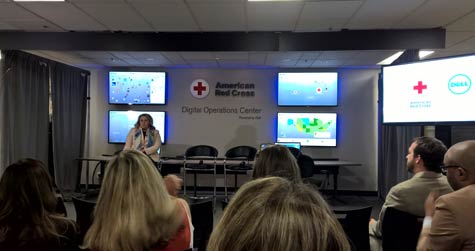I was in San Jose this week for the unveiling of the latest in a series of Dell-funded Digital Operations Centers for the Red Cross. Given that this is a technology that could provide necessary help during a catastrophe and even save our lives, I was unimpressed with the unveiling of what looked like four floating TVs that no-one was watching. This presentation showcased how hard it is to exhibit a technology that is largely being used by people who work remotely. I’d expected a huge heavily staffed operations center, but when folks are mostly remote, you really don’t need one. In effect, the power of the project wasn’t in the building and it wasn’t designed to be.
Let’s talk about this project and the problems involved in showcasing a system that is used by people who will never be anywhere near it.
The Digital Operations Center
This is a fascinating project that uses Salesforce Radian 6 to manage a massive number of social network events. What the Red Cross found was that during a disaster, folks on the ground were providing better and timelier information than what was coming in on official channels. It also found out that three-quarters of those affected by a disaster expected help to arrive within an hour (which also suggests that these people are way the hell too optimistic).
The problem was that staffing an effort to do this manually would have been far too labor intensive, because you’d have to manually wade through all of the false social media comments to collect the ones that told you something important and then analyze them. This is an ideal task, though, for a tool like Salesforce’s social media tool set and Dell Services/Consulting because they have set up similar systems to help with product marketing and social media response. You can get a sense for the interaction between Dell and the Red Cross in this Social Worker article.
It works because they use the tool to gather and filter social media data, but just change the deliverable from a marketing/product response to the kind of response the Red Cross is known for. Suddenly, you have a sharp connection between the folks who need help and the leading organization providing it. This response can range from telling people where they need to go and what they need to take to stay safe (i.e., in the event of a tornado, go to the cellar and take a radio and a flashlight) to directing people to food trucks like they did during the Sandy weather disaster.
Future Efforts
While this digital operations center effort is a fascinating one to me—primarily because where I live has its fair share of disasters—there are some interesting places where the Red Cross plans to take this technology.
Red Cross wants to better motivate folks to give blood by creating a closer social connection between them and those that need it. No, I don’t think you’ll be able to call the guy to whom you gave blood and ask him for a ride or a handout in exchange, or request that a donor have a particular diet (e.g., vegetarian blood—you know folks would love to specify that), but collectively, you’ll be able to eventually learn about some of the folks you helped, and collectively, they’ll learn about some of the donors.
This will be a fascinating project because the separation between the donors and recipients will have to remain near absolute, yet still pass through stories from both groups so that they feel connected to each other. It will likely be some kind of an abstraction of Facebook with a heavy opt-in component to protect the various parties and their personal information. But stories of how recipients were helped by the blood and stories about the amazing donors should help motivate people to donate and increase the blood supply.
Additional efforts will drum up volunteer recruitment (they need digital volunteers for this service if you are interested) and coordination, among other things. I imagine, eventually, an AI-based intelligent analytics component would be incredibly useful.
The Problem
However, all of this highlighted a big problem with this kind of solution. How do you showcase it? Given that the people who volunteer to respond to those in need and help coordinate the physical response are remote, the idea of a typical operations center no longer really makes sense. Folks are accessing the system from their homes often on their own PCs, tablets and maybe even cell phones.
It strikes me that the one display that wasn’t used is one that would showcase this as a map with dots showing the locations and activities of all of the hundreds of volunteers working the system coupled with a feed of the interactions. But showcasing a near empty operations center just doesn’t convey the power of a solution like this unless you can, in some way, showcase the people who are using this technology.
Wrapping Up: Bringing Remote Work Closer
We increasingly live in a world where employees and volunteers may never come into the office and might literally (as was the case with this system) live anyplace in the world. Coming up with creative ways to keep these people productive and effective will be a major portion of what firms like Salesforce and Dell will be doing going forward. Showcasing the results, given the history of the huge boiler-room kind of operations, will require a little creativity. But the tools for that exist—they just need to be brought forward so the power of these new models can be better showcased in order to convince companies of the value for these solutions, showcase best practices, and drive business to the vendors who are creating them.
In the end, this endeavor shows that Dell and Salesforce are leaders in this effort. It also reiterates why the Red Cross is so well regarded when it comes to charitable work. This is a fascinating project and the next time you find yourself or a loved one in a disaster, ping out on Twitter with the hash tag #redcross. You may be surprised at the response.
Rob Enderle is President and Principal Analyst of the Enderle Group, a forward-looking emerging technology advisory firm. With over 30 years’ experience in emerging technologies, he has provided regional and global companies with guidance in how to better target customer needs; create new business opportunities; anticipate technology changes; select vendors and products; and present their products in the best possible light. Rob covers the technology industry broadly. Before founding the Enderle Group, Rob was the Senior Research Fellow for Forrester Research and the Giga Information Group, and held senior positions at IBM and ROLM. Follow Rob on Twitter @enderle, on Facebook and on Google+.




